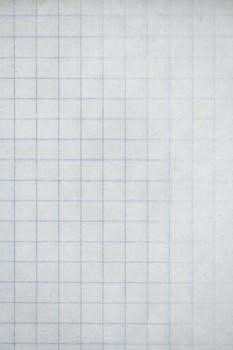Overview of Common Core Math Grade 5
Fifth grade Common Core Math is designed to build upon prior knowledge. It is also designed to provide a strong foundation for future mathematical studies. Key areas include fractions, decimals, and geometric thinking that are crucial for success.
What is Common Core Math?
Common Core Math is a set of educational standards. These standards outline what students should know at each grade level. The goal is to ensure consistency in math education across different states. Common Core aims to develop a deeper understanding of mathematical concepts. It emphasizes problem-solving and critical thinking skills over rote memorization. The standards cover various mathematical topics, including number sense, algebra, geometry, and data analysis. Common Core Math promotes a more rigorous and focused curriculum. It prepares students for college and careers by building a solid foundation in mathematical principles. The standards encourage active participation and engagement in the learning process. Common Core Math seeks to equip students with the necessary tools to succeed. It equips them in a complex and rapidly changing world through a uniform math education.
Key Areas of Focus in 5th Grade Math
Fifth grade Common Core Math focuses on several crucial areas to build a strong foundation. A primary focus is on fractions, including adding, subtracting, multiplying, and dividing fractions with unlike denominators. Students deepen their understanding of place value and perform operations with multi-digit whole numbers and decimals. Another key area is algebraic thinking, where students write and interpret numerical expressions. Geometry is also emphasized, with students graphing points on the coordinate plane and classifying two-dimensional figures. Measurement and data are crucial, with students converting measurement units and understanding volume. These key areas are interconnected, fostering a comprehensive understanding of math. The goal is to equip students with essential skills for future math courses. Furthermore, it equips students to apply mathematical concepts in real-world situations, making math relevant and engaging.

Operations and Algebraic Thinking
In fifth grade, operations and algebraic thinking involve writing and interpreting numerical expressions. Students also analyze patterns and relationships to solve mathematical problems, enhancing analytical skills.
Writing and Interpreting Numerical Expressions
Fifth-grade students delve into the world of numerical expressions, learning how to accurately write and interpret them. This involves using parentheses, brackets, and braces to dictate the order of operations within an expression, in accordance with the Common Core standards. Students learn to evaluate expressions containing these symbols, solidifying their understanding of mathematical conventions.
Furthermore, fifth graders are taught to translate real-world scenarios into numerical expressions. They also learn to interpret existing numerical expressions without necessarily calculating their values. For instance, they can understand that “3 x (15 + 25)” represents three times the sum of fifteen and twenty-five, emphasizing the relationships between the numbers and operations involved.
This skill builds a strong foundation for more complex algebraic concepts in later grades, enabling students to analyze and solve problems using mathematical language and reasoning, as specified by the Common Core curriculum.
Analyzing Patterns and Relationships
In fifth grade, analyzing patterns and relationships is a core skill within the Common Core math curriculum. Students explore numerical patterns and relationships, bridging the gap between operations and algebraic thinking. This involves identifying rules for patterns. It also involves extending patterns to predict future terms.
Fifth graders learn to generate two numerical patterns using two given rules. They can form ordered pairs consisting of corresponding terms from the two patterns. They also learn how to graph these ordered pairs on a coordinate plane. They then analyze the relationship between the two patterns visually, using the graph.
For example, one pattern could involve adding three to each term, while the other involves adding five. By graphing the resulting ordered pairs, students can observe the constant relationship between the two patterns. This analytical approach fosters a deeper understanding of mathematical relationships and sets the stage for future algebraic studies, emphasizing problem-solving and critical thinking.

Number and Operations in Base Ten
Fifth grade math delves into the base ten system. Students are learning to master multi-digit operations. Decimals are introduced. Emphasis on place value is important for success.
Understanding the Place Value System
In fifth grade, understanding the place value system is crucial. This involves recognizing that a digit in one place represents ten times what it represents in the place to its right and 1/10 of what it represents in the place to its left.
Students extend their understanding of place value to include decimals, recognizing tenths, hundredths, and thousandths. They learn to read, write, and compare decimals to thousandths using base-ten numerals, number names, and expanded form.
For example, they understand that 347.392 is 3 hundreds, 4 tens, 7 ones, 3 tenths, 9 hundredths, and 2 thousandths. Comparing decimals involves understanding the relative size of decimal values. Place value understanding is foundational for performing operations with multi-digit whole numbers and decimals.
Performing Operations with Multi-Digit Whole Numbers and Decimals
Fifth grade students build upon their prior knowledge of multiplication and division to fluently multiply multi-digit whole numbers using the standard algorithm. This involves breaking down the numbers and applying the distributive property to find the product.
They also focus on dividing multi-digit numbers, interpreting remainders, and solving real-world problems. An important aspect is adding, subtracting, multiplying, and dividing decimals to hundredths. Students use concrete models, drawings, and strategies based on place value, properties of operations, and the relationship between addition and subtraction or multiplication and division to solve these problems.
This includes estimating answers and assessing the reasonableness of results. Mastery of these operations is critical for continued success in mathematics.

Number and Operations ⸺ Fractions
Fifth grade focuses intensely on fractions. Students learn to add, subtract, multiply and divide fractions. These operations build a strong understanding of fraction equivalence; They learn to solve real-world problems.
Adding and Subtracting Fractions with Unlike Denominators
A core concept in 5th grade is adding and subtracting fractions. It also includes unlike denominators. This requires students to find common denominators first. Students need to create equivalent fractions before performing the operations. This involves finding the least common multiple of the denominators. It will help to rewrite fractions with a common denominator. For example, to add 1/3 and 1/4, students find the common denominator of 12. They will rewrite the fractions as 4/12 and 3/12, respectively. Then they can easily add the numerators⁚ 4/12 + 3/12 = 7/12. This skill is essential. It builds a foundation for more complex fraction operations.
Multiplying and Dividing Fractions
Fifth grade math extends fraction understanding to multiplication and division. Students learn to multiply a fraction by a whole number. They also learn to multiply a fraction by another fraction. Visual models are often used to illustrate these concepts. For example, 2/3 multiplied by 1/2 can be shown. It can be shown as taking half of two-thirds. Division of fractions introduces dividing unit fractions. It includes dividing unit fractions by whole numbers and whole numbers by unit fractions. Students create story contexts. They will use visual models to understand the quotient. Understanding the relationship between multiplication and division is emphasized. This builds a solid base for algebra.
Measurement and Data
Fifth grade measurement and data focuses on converting units. It also focuses on understanding volume. Students solve real-world problems involving measurement. This combines practical skills with mathematical concepts and applications.
Converting Like Measurement Units
In fifth grade, students delve into the practical skill of converting like measurement units within a single system. This involves understanding the relationships between different units of measure, such as converting centimeters to meters or inches to feet. The goal is to enable students to fluently convert units and apply these conversions to solve multi-step, real-world problems.
For example, students might convert 5 cm to 0.05 m. They also use these conversions in solving multi-step, real-world problems. This skill reinforces their understanding of the metric system and customary units. It also enhances their problem-solving abilities in practical contexts. This ensures a solid grasp of measurement concepts.
Understanding Volume
Fifth-grade students begin to explore the concept of volume as an attribute of solid figures. They learn that volume is measured by counting unit cubes, typically cubic centimeters or cubic inches, needed to fill the space. Students develop an understanding of volume as the amount of space within a three-dimensional shape.
They apply formulas such as V = l x w x h (volume equals length times width times height) for rectangular prisms. Students use these formulas to solve real-world and mathematical problems involving volume. This involves calculating the volume of various objects, reinforcing their understanding of spatial reasoning. They also use real-world examples for context.

Geometry
Fifth grade geometry involves graphing points and classifying two-dimensional shapes. This helps students develop spatial reasoning. It also helps them understand geometric properties. These are crucial geometry foundations.
Graphing Points on the Coordinate Plane
In fifth grade, graphing points on the coordinate plane becomes a crucial skill. Students learn to represent real-world and mathematical problems by plotting ordered pairs. This involves understanding the x-axis and y-axis as perpendicular number lines that define a two-dimensional space. Each point is located by its unique coordinates (x, y).
Fifth graders use this skill to interpret coordinate values within the context of a problem. This includes understanding that the first number indicates horizontal position. The second number indicates vertical position. They apply coordinate graphing to solve problems involving distance, patterns, and relationships.
Furthermore, students connect coordinate graphing to other mathematical concepts. They connect coordinate graphing to concepts such as measurement and data. They also connect coordinate graphing to algebraic thinking, and geometric relationships. This solidifies their understanding of how mathematical concepts are interconnected and applicable in various situations. Mastering this skill is essential for future success in algebra and higher-level mathematics.
Classifying Two-Dimensional Figures
Fifth-grade students delve into classifying two-dimensional figures based on their properties. This involves understanding attributes like angles, sides, and symmetry. They learn to categorize shapes into hierarchies based on these attributes. For instance, recognizing that a square is a special type of rectangle and a rectangle is a special type of parallelogram.
Students analyze the properties of different quadrilaterals. Students will analyze the properties of triangles and polygons. This deepens their understanding of geometric relationships; They learn to identify and classify figures based on parallel, perpendicular, and congruent sides. They also classify figures based on angle measures.
This skill enhances their spatial reasoning and problem-solving abilities. Furthermore, it provides a foundation for more advanced geometry concepts. Classifying shapes also helps students develop logical thinking. They develop logical thinking by making connections between geometric properties and categories. This knowledge is essential for success in future mathematics courses and real-world applications involving geometry.
